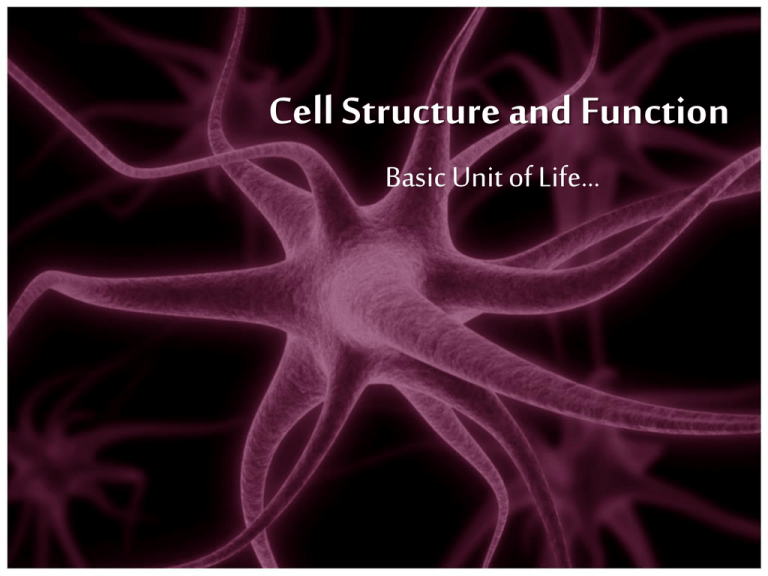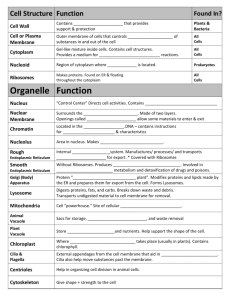Discovering Cells
advertisement

Cell Structure and Function Basic Unit of Life… Objectives • The learner will be able to: – Tell what cells are. – State the cell theory and identify the components of the cell theory. – Identify the role of the cell wall and the cell membrane in the cell. – Describe the functions of the cell. – Explain how cells are organized in many-celled organisms. – Describe diffusion, osmosis, active transport, and facilitated diffusion. BEFORE ACTIVITY Active Art Go to phschool.com Type the code cbp-3072 Follow directions and take the quiz at the end. BEFORE ACTIVITY Possible Sentences • • • • • Cells Eukaryotes Prokaryotes Unicellular Multicellular • • • • • Microscopic Organelles Nucleus DNA Organisms History of the Cell • The invention of the microscope made it possible to discover and study cells. – The scientists who contributed to the microscope are: • Hans and Zacharias Janssen • Robert Hooke • Anton Von Leeuwenhoek History of the Cell • Who discovered the cell and gave it its name? • Robert Hooke • When did he discover the cell? • 1663 • How did he discover the cell? • Using his version of the Compound Microscope. • He was viewing a piece of cork. History of the Cell (cont.) Robert Hooke’s Compound Microscope Robert Hooke Cell Overview • Cells are the basic unit of structure and function in ALL living things. – Cell form parts of the organs and perform all functions for the organ. • All cells are surrounded by a cell membrane. • All cells contain DNA at some point in their life. • Most cells are made up of tiny structures called organelles. • One square centimeter of your skin is made up of more than 100,000 cells. Development of the Cell Theory • 3 German Scientists made important contributions to our knowledge of the cell. – Matthias Schleiden – Theodore Schwann They developed the first two points of the cell theory, but did not explain where cells come from. – Rudolf Virchow discovered all cells come from cells. Cell Theory • All living things are composed of cells. • Cells are the basic units of structure and function in living things. • All cells are produced from other cells. Prokaryotes vs. Eukaryotes • All cells fall into two categories (eukaryotes and prokaryotes) depending on whether they have a nucleus or not. – Karyon means “kernel” or “nucleus” Prokaryotes Eukaryotes •Cells that do not contain nuclei. • pro- means before •Genetic material is not contained in a nucleus. •They have all the characteristics of life such as reproduction, responding to the environment, and growing. •Ex. Bacteria •Cells that contain nuclei. • Eu- means true •Contains dozens of structures that are highly specialized •Genetic material is contained in the nucleus away from everything else. •Ex. Plants, Animals, Fungi, and Protists Keys to Understanding Cells Anatomy Students need these!!! • Cyt- : [cell] Ex. Cytoplasm fluid (cytosol) • Endo-: [within] Ex. Endoplasmic reticulum (membranous structure within the cell • Hyper-: [above] Ex. Hypertonic solutions have greater osmotic pressure than body fluids. • Hypo- : [below] Ex. Hypotonic solutions have lower osmotic pressure than the body fluids. • Inter-: [between] Ex. Interphase is the stage between divisions of a cell. • Iso- [equal] Ex. Isotonic solutions have the same osmotic pressure as body fluids. • Mit- [thread] Ex. Mitosis is cell division when thread-like chromosomes become visible. • Phag- [to eat] Ex. Phagocytosis takes place when a cells takes in solid particles. • Pino- [to drink] Ex. Pinocytosis takes place when a cell takes in tiny drops of liquid. • -som [body] Ex. Ribosomes are tiny structures that consist of protein and RNA. Looking Inside The Cell Looking Inside The Cell – Contains nearly all of the cell’s DNA, – dense region • Nucleus which controls the cell’s activities. – Enclosed in a double-layered (lipid) membrane called the nuclear envelope. • Nuclear pores allow materials to move in and out. – Chromatin is found in nucleus. • Consists of DNA and proteins. • Condenses into chromosomes during cell division (i.e. mitosis, meiosis) • Nucleolus found inside the nucleus – Ribosomes are made in the nucleolus and leave through the nuclear pores into the cytoplasm Looking Inside The Cell • Cytoplasm: clear, thick, gel-like fluid between the cell membrane and the nucleus; it is constantly moving – It contains networks of membranes and organelles suspended in a clear liquid called cytosol • Cytoskeleton: a network of protein filaments (rods and tubules) that help the cell maintain its shape. • In animal cells, the microfilaments form centrioles (used during cell division) Check Point 1) What structure separates the nuclear contents from the cytoplasm? 2) What is produced in the nucleolus? 3) What is chromatin? 4) What structures are produced by the cytoskeleton? Looking Inside The Cell • Ribosome: “factories” to produce proteins; some are attached to Endoplasmic Reticulum and other float in the cytoplasm • Endoplasmic Reticulum: passageways that carry proteins and other materials from one part of the cell to another; similar to hallways of a building • Lipid components of the cell are assembled here Looking Inside The Cell • Mitochondria: the “powerhouse” of the cell; converts nutrients in food to energy for the cell. – Surrounded by two membranes • Golgi Apparatus: the cell’s “mail room” – receive proteins from the endoplasmic reticulum and it modifies, sorts, and packages them for storage or secretion • Lysosomes: the “clean up crew” of the cell – small, round structures containing enzymes that break down lipids, carbohydrates, and proteins into small molecules to be used by the cell. – Breaks down old organelles Looking Inside The Cell • Vacuoles: water filled sac that stores food and other nutrients needed by the cell. – Plants have one large Central Vacuole – Some animal cells have them and others don’t • Chloroplasts: (only in a plant cell) large green structures that capture energy from the sun and covert it into chemical energy (food for the plant) in a process called photosynthesis. – Surrounded by two membranes – Contains the green pigment chlorophyll Cell Boundaries • Cell Membrane: controls what substances enters and leaves the cell; nutrients enter here and wastes leave here. – – – – Provides protection and support It is a double layered sheet called lipid bilayer Also has proteins embedded in lipids Selectively permeable (semipermeable) meaning it only allows certain substances to enter or leave the cell. • Cell Wall (only in plant cells): rigid layer of nonliving material that surrounds the cell; it provides support and protection – Composed mainly of cellulose, a tough carbohydrate fiber. Movement Through Cell Boundaries • Diffusion – Particles move from an area of high concentration to an area of low concentration. – When the concentration of a solute is the same on both sides of the membrane, the system (organism) has reached equilibrium. Movement Through Cell Boundaries • Osmosis – The diffusion of water across a semipermeable membrane. – Water moves across membranes until equilibrium is reached. • When equilibrium is reached (same strength inside and outside the cell) the solution is isotonic (same strength). • When the solution on one side of membrane is more concentrated (stronger) other side , it is hypertonic. • When the solution on one side of the membrane is less concentrated than the other side, it is hypotonic. Movement Through Cell Boundaries • Osmotic Pressure – Osmosis exerts pressure on the hypertonic side of the permeable membrane. – Cells are filled with salts, sugars, proteins, etc.; so, they would always be hypertonic when placed in fresh water. – Cells are never in fresh water because body fluids like blood have the same concentrations of dissolved materials. They are ISOTONIC! – Plant cells and Bacteria come in contact with fresh water, but the cell walls protect the membranes from bursting. Movement Through Cell Boundaries • Facilitated Diffusion – The cell membrane has protein channels that allow certain molecule to pass into and out of the cell. – These channels are selective. • Ex. Only glucose (sugar) can pass through a channel made for glucose. • They are not “one-size-fitsall” Movement Through Cell Boundaries • Active Transport – Requires energy – Movement against the concentration – Accomplished by protein “pumps” in the cell membrane. • Endocytosis: the process of taking material into the cell by means of pockets on the cell membrane. – The pocket that is formed during endocytosis breaks away from the membrane and forms a vacuole. Movement Through Cell Boundaries • Phagocytosis 1. Extensions of cytoplasm surround a particle and package it within a food vacuole. 2. The cell engulfs it. 3. The vacuole breaks from the membrane. • Pinocytosis 1. Tiny pockets form along the membrane. 2. The pockets fill with liquid. 3. The pockets form vacuoles. • Exocytosis – The membrane of a vacuole fuses with the membrane – Contents are forced out of the cell. Cellular Organization • Unicellular Organisms – Single-celled organisms – Carry out all characteristics of life. • • • • Reproduce Grow Respond to the environment Transform energy – Ex. Yeast, Bacteria, and some Alga Cellular Organization • Unicellular Organsims – Organisms composed (made) of many cells – Depends specialized cells cooperating with each other. – Cells develop specialized tasks. • Examples of Specialized Cells… – Red Blood Cells transport oxygen. – Muscles Cells specialized for movement. – Pancreatic Cells produce proteins and enzymes for digestion. Levels of Organization Organ Systems A group of organs that work together to perform a specific function. Organs Many groups of tissues that work together. Tissues A group of similar cells that perform a particular function.








